Energy Awareness Bingo
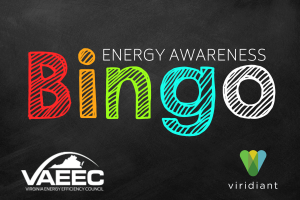
Play all October for a chance to win a virtual home energy audit from Viridiant!
October 1st kicks off National Energy Awareness Month, a time to promote the importance of energy efficiency, discover new ways to become more efficient, and reflect on your own energy consumption. To get everyone in on the fun, the Virginia Energy Efficiency Council will be orchestrating Energy Awareness Bingo! Get rewarded for energy-efficient measures you have already implemented while learning about additional ways to reduce your energy footprint. Winners will be entered into a raffle to win a virtual home energy audit* from Viridiant! The raffle winner will be announced at our free virtual Fall Forum on November 10th.
See official rules and a description of the prize at the bottom of the page. Contact us at info@vaeec.org with any questions.
Guidelines
- Sign up to play. Simply fill out this quick form to download a bingo card.
- Once you receive your virtual bingo card, mark any of the squares that contain an energy efficiency measure that you have taken at your home. Marks can be done virtually or by printing out your card and writing on it.
- To qualify, all energy efficiency measures must have been implemented within the past three years.
- Have fun while learning new ways to make your home more efficient!
- If you get “bingo”, take a photo or screenshot of your card and post it to social media. Get creative! Be sure to tag us and use the hashtag #EEbingo.
- Facebook: @vaeec
- Twitter: @SmartEnergyVA
- LinkedIn: Virginia Energy Efficiency Council
- Register for the virtual Fall Forum on November 10th to see if your name is drawn for the grand prize, a virtual home energy audit from Viridiant.
Tips to Reduce Your Energy Consumption – and Utility Bills
Below you will find a brief description of the measures or habits included on each card. The majority of them are no- or low-cost measures or simple behavioral changes that reduce your energy consumption and save you money on your utility bills.
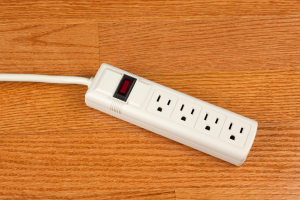 Use smart power strips. Many electronics produce “phantom loads”, which refers to the electricity used by electronics when they are either in standby mode or are turned off. This wasted energy can cost you up to $200 per year. In fact, estimates suggest that stand by power accounts for over $11 billion in annual U.S. energy costs. Smart power strips shut off the power to electronics when they are not in use.
Use smart power strips. Many electronics produce “phantom loads”, which refers to the electricity used by electronics when they are either in standby mode or are turned off. This wasted energy can cost you up to $200 per year. In fact, estimates suggest that stand by power accounts for over $11 billion in annual U.S. energy costs. Smart power strips shut off the power to electronics when they are not in use.- Install low-flow plumbing fixtures. Along with saving water, low-flow plumbing fixtures reduce the energy it takes to heat the water. Even without new, efficient fixtures, you can save money by making more conscious decisions. For example, turn off the water when you’re brushing your teeth or shaving, and don’t rinse dishes before placing them in the dishwasher.
- Add (additional) attic insulation. Attic insulation slows the rate of heat leaving the house in the winter or entering the house in the summer, thus requiring less energy to heat or cool your home. If your older home already has insulation, it might be time to add more. Insulation settles with age, thus reducing it’s R-value. Homeowners typically reduce their heating and cooling costs by up to $200 by adding insulation and air sealing their homes. This includes sealing the entire home’s thermal envelope, such as the foundation, walls, roof, doors, and windows (think anything that separates your living space from the outside).
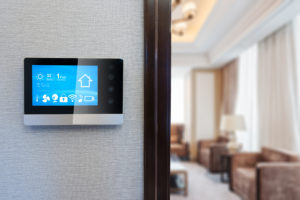 Use a smart, programmable thermostat. Programmable thermostats automatically turn off or reduce heating and cooling when you are away from home or asleep. This eliminates wasteful energy consumption without having to upgrade your HVAC system. On average, they save households $180 per year. Many models even include indicators for replacing your air filter or HVAC problems, which improves the efficiency of your HVAC system. Additionally, consider setting your thermostat to 78F in the summer and 68F in the winter. For every degree extra of heating or cooling, you’re increasing your energy usage by 6-8%. Note, setting your thermostat to a lower temperature than normal does not cool your home faster.
Use a smart, programmable thermostat. Programmable thermostats automatically turn off or reduce heating and cooling when you are away from home or asleep. This eliminates wasteful energy consumption without having to upgrade your HVAC system. On average, they save households $180 per year. Many models even include indicators for replacing your air filter or HVAC problems, which improves the efficiency of your HVAC system. Additionally, consider setting your thermostat to 78F in the summer and 68F in the winter. For every degree extra of heating or cooling, you’re increasing your energy usage by 6-8%. Note, setting your thermostat to a lower temperature than normal does not cool your home faster.- Upgrade to an ENERGY STAR appliance. If you need to replace a household appliance, consider upgrading to an ENERGY STAR certified one. Appliances, on average, account for approximately 13% of a household’s energy use. Energy-efficient appliances usually have a higher upfront purchase cost, but their operating costs tend to be 9-25% lower than conventional models. ENERGY STAR labels are a guarantee that the appliance consumes less energy than standard models.
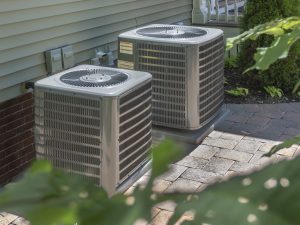 Get an HVAC tune-up. Annual heating and cooling system check-ups keep your system at peak performance and can prevent future problems. The average homeowner spends about $875 a year on heating and cooling costs. Some money-saving measures include using a programmable thermostat, cleaning the area around your HVAC system’s outdoor components, and regularly changing your air filters. Additionally, have your HVAC professional check your ducts for leaks too.
Get an HVAC tune-up. Annual heating and cooling system check-ups keep your system at peak performance and can prevent future problems. The average homeowner spends about $875 a year on heating and cooling costs. Some money-saving measures include using a programmable thermostat, cleaning the area around your HVAC system’s outdoor components, and regularly changing your air filters. Additionally, have your HVAC professional check your ducts for leaks too.- Receive an energy audit. Using specialized tools and skills to evaluate your home, energy auditors and raters recommend the most cost-effective measures to improve its efficiency and comfort. They can also recommend the best sequence for implementing measures to help you take advantage of interactions.
- Participate in the Dominion Energy Marketplace. Dominion Energy customers can purchase energy-efficient products at a discounted price through the company’s online marketplace. Products include an array of LED bulbs, smart power strips, and outdoor motion/sensing lights. Orders over $35 ship free.
- Switch to LED light bulbs. LED light bulbs use anywhere from 25-80% less electricity than traditional incandescent bulbs, and they last between 3-25 times longer.
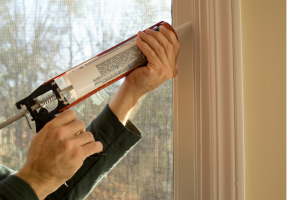 Seal cracks, gaps, and leaks. Weatherizing your home by sealing air leaks is a low-cost, effective way to reduce your home’s heating and cooling costs. Vents, windows, and doors are the most common sources of leaks. Apply caulk or spray foam to seal air leaks between stationary objects. Weather striping can be used for cracks between moving objects, such as doors and windows. These low-cost measures typically offer a return on investment in less than one year.
Seal cracks, gaps, and leaks. Weatherizing your home by sealing air leaks is a low-cost, effective way to reduce your home’s heating and cooling costs. Vents, windows, and doors are the most common sources of leaks. Apply caulk or spray foam to seal air leaks between stationary objects. Weather striping can be used for cracks between moving objects, such as doors and windows. These low-cost measures typically offer a return on investment in less than one year.- Upgrade or replace windows. Old, inefficient windows can add up to 10-25% of your total heating bill. Replacing single-glazed windows with energy-efficient models can result in noticeable cost savings. An alternative option is to add interior or exterior storm windows, which can reduce heat loss by 10-20%. If you are already planning on replacing your home’s windows, the typical additional cost of ENERGY STAR-rated replacement windows is modest and can be cost-effective while also boosting your home’s comfort. Depending on your location, ENERGY STAR windows can save anywhere from $20-95 a year on your energy bills.
- Insulate your electric hot water heater and hot water lines. Insulating your water heater and hot water lines helps keep the heated water from cooling off as quickly between uses. On average, households spend over $250 a year on water heating. You can also save money by lowering your water heater’s temperature setting.
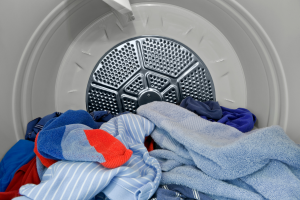 Wash clothes in cold water, when possible. Using cold water uses less energy because you don’t have to heat the water. About 90% of the energy used to operate a clothes washer is from water heating. To save even more, wash full loads or use lower water settings for smaller loads. Additionally, longer spin times in the washing machine reduces the amount of drying time needed in the dryer.
Wash clothes in cold water, when possible. Using cold water uses less energy because you don’t have to heat the water. About 90% of the energy used to operate a clothes washer is from water heating. To save even more, wash full loads or use lower water settings for smaller loads. Additionally, longer spin times in the washing machine reduces the amount of drying time needed in the dryer.- Use clothes dryers efficiently (if used at all). Dryers account for 6% of residential electricity consumption. Luckily, there are several easy-to-implement tips to make your dryer more efficient. Don’t overstuff the dryer, which causes it to run longer. Lower heat settings use less energy. Use the moisture sensor option, if available, which helps avoid over-drying clothes. Clean the lint trap after every use to improve air circulation to increase the dryer’s efficiency. Use your washing machine’s highest spin time to reduce the amount of drying time needed.
- Clean or replace filters regularly. It’s recommended that you check your HVAC system’s air filters monthly, especially during times of heavy use. If it looks dirty, change it. At a minimum, HVAC filters should be changed every three months. Dirty filters make your system work harder by slowing down airflow. For an even greener option with a bigger payback, check to see if your system accommodates a washable filter.
- Plant shade trees around your home. Good landscaping can save energy, especially if you live in an older home with relatively poor insulation and windows. Planting deciduous trees on the western side of your home block solar radiation in the summer and lets the radiation through in the winter.
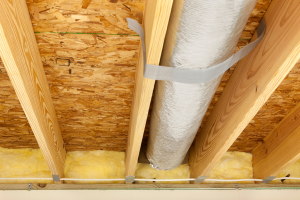 Insulate your HVAC ducts. Most HVAC systems consist of a network of ducts that distribute the warmed or cooled air to different parts of your home. If they are not properly insulated or sealed, the resulting energy waste could be adding hundreds of dollars to your annual heating and cooling bills.
Insulate your HVAC ducts. Most HVAC systems consist of a network of ducts that distribute the warmed or cooled air to different parts of your home. If they are not properly insulated or sealed, the resulting energy waste could be adding hundreds of dollars to your annual heating and cooling bills.- Avoid running appliances during peak hours. Consider using your dishwasher and clothes washer/dryer later in the evening. Not only will this help keep your house cooler during summer months, avoiding peak usage hours (4:00-6:00 pm) will save on your utility bill.
- Watch your appliance placement. Placing heat-generating appliances, such as TVs, computers, or lamps, near a thermostat can make your HVAC unit run more than it needs to.
- Close the fireplace damper when not in use. Opened dampers allow warmed or cooled air to easily escape from the house. Closing the damper will help keep your conditioned air in the living space. For an even more efficient option, consider a chimney plug or fireplace balloon.
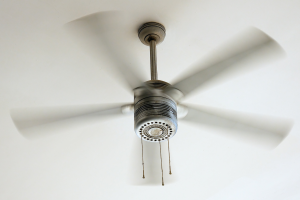 Use your ceiling fan. A ceiling fan can allow you to raise your thermostat setting about 4F while still remaining comfortable. Just remember to turn the fan off when you leave the room; fans cool people, not the room. In the winter, you can reverse your fan to produce a gentle updraft, which drives the warm air near the ceiling down into the living space.
Use your ceiling fan. A ceiling fan can allow you to raise your thermostat setting about 4F while still remaining comfortable. Just remember to turn the fan off when you leave the room; fans cool people, not the room. In the winter, you can reverse your fan to produce a gentle updraft, which drives the warm air near the ceiling down into the living space.- Cook efficiently. If you’re using your stove, avoid wasting energy by covering pots and pans. Trapping the heat also reduces cooking times. In fact, covering your pot when using an electric cooktop can reduce your carbon footprint by roughly 85 lbs of CO2 per year. You should also match your pot size to your burner size. When using the oven, resist the urge to open the door to check on your food, which allows the heat to escape. Every time you open that door, the temperature can drop 25F. Use your oven light and look through the door’s window instead. Finally, use the microwave for cooking. Using the microwave can reduce your cooking energy by as much as 80%. Additionally, by generating less heat than an oven or stovetop, you also save on AC costs.
- Defrost refrigerators and freezers. Ice build-up over ¼ inch thick can reduce your appliance’s efficiency. Additionally, fridges and freezers operate most efficiently when they’re full, so keep them as full as possible (without overfilling them). To avoid excessive cooling and wasting energy, you should also make sure to set your refrigerator temperature to the manufacturer’s recommendation.
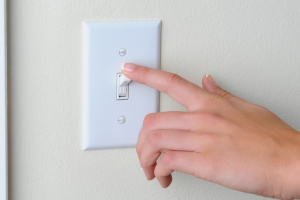 Turn off lights when not in use. Approximately 12% of a typical household utility bill is from lighting. During the day, open curtains and blinds to rely more on natural light than lamps.
Turn off lights when not in use. Approximately 12% of a typical household utility bill is from lighting. During the day, open curtains and blinds to rely more on natural light than lamps.- Unplug electronics when not in use. As mentioned above, many electronics produce “phantom loads”, or electricity used by electronics when they are either in standby mode or are turned off. This wasted energy can cost you up to $200 per year. Only turn on your computer, monitor, printer, etc. when you need them. And while you’re at it, don’t leave your cell phone plugged in overnight; it only takes 1-2 hours to charge.
*VAEEC is partnering with Viridiant to offer the Energy Awareness Bingo Grand Prize! Announced at the Fall Forum on November 10th, the raffle winner will receive a virtual Home Energy Audit from Viridiant. Conducted via video-chat, Viridiant’s 1-hour audit with a building science expert will provide a whole-house inspection, utility bill analysis, and a prioritized list of improvements affecting energy costs, health, and comfort for your home. Viridiant is a non-profit advancing sustainable, affordable and energy-efficient construction through education and technical support. Learn more about their work and mission at viridiant.org.
No purchase necessary. Promotion begins on October 1st. Entries must be received by October 31st. One (1) winner will receive the following prize: One (1) Virtual Home Energy Audit. Winner will be announced on November 10th during the VAEEC’s virtual Fall Forum. Odds of winning depend on number of entries received. Promotion open only to U.S. citizens, or lawful permanent U.S. residents who live within Virginia and are 18 or older. Prize must be redeemed within 6 months of notice to winner. Sponsor: Viridiant, 1431 East Main Street, Richmond, Virginia 23220.
